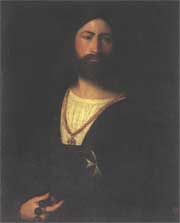Knights Of Malta
The Knights of Malta was the name given to the Knights Hospitaller (or the Knights of Saint John of Jerusalem), after they established their headquarters in Malta. The island was given to them by Emperor Charles V in 1530.

Tiziano Vecellio
A Knight of Malta
1510-15
Galleria degli Uffizi, Florence
The Knights Hospitaller did not obtain the island easily. Charles was hesitating, first because the Grand Master was a Frenchman, and second, because of the Order's close relations with the Papacy. Finally, on March 24, 1530, the Emperor granted the "isles of Tripoli, Malta and Gozo, with all their territories and jurisdictions" to the Knights Hospitaller Order.
On October 26 1530, the Grand Master Philip de Villiers de L'Isle-Adam took formal possession of the island, and Castle Saint Angelo became the headquarters of the Order of the Knights of Malta.
The Knights of Malta in the Mediterranean
The Order of Malta became an important player in the Mediterranean theatre of operations. The Knights were part of the fleet assembled by Charles V and the Pope, in order to stop Barbarossa's piracy incursions in the Mediterranean. The fleet set sail in June 1535, under the command of Andrea Doria. The force laid siege to Goletta, a fortified place near Tunis. After fierce fighting, in which the members of the Order proved their bravery, the place was taken. The Emperor forces then attacked and conquered Tunis.
The next great expedition in which the Knights took part was the siege of Algiers in 1541. Andrea Doria advised the Emperor to delay the operations because of bad weather, but Charles' impatience won, and the fleet hastily set sail. A storm destroyed the greater part of the fleet. Left without provisions, the ground army withdrew, the expedition ending in failure.
The Knights of Malta established themselves as a great naval power. Their ships were unrivalled both for size and for the quality of their construction. The great ship of the Order was of a huge size, and was made shot-proof by being shielded with iron plates.
The increasing power of the Order collided with the Sultan's own ambitions, and the Ottomans assembled a great army and fleet in order to attack the Malta stroghold. On July 16, 1551, the Turkish fleet appeared off the island. The attackers sent some formations to search for the best place where the main force was to land, but these were intercepted and beaten by the Knights. After a Council of War, the Turks decided to abandon the attack and to sail to Tripoli.
The garrison of Tripoli under De Valier failed to defend the city and surrendered. On his return to Malta, De Valier and his companions were tried for giving a place entrusted to them by the Order, and condemned to imprisonment. Many members of the Supreme Council of The Knights of Malta, together with other knights, considered the punishment unjust. This led to tensions within the Order, rendering the Grand Master D'Omedes, an Aragonese, very unpopular.
The Great Siege
The Knights of Malta improved the fortifications of the island. The Fort of St. Elmo and the Fort of St. Michael were added to the defenses. In August 1557, Jean de La Valette was elected Grand Master. He had already detained many important offices, and he was known for his bravery, his administrative skills, and his perfect conduct.
Intelligence gathered by the Order was showing that the Sultan was preparing a new attack against the island. The Grand Master proceeded with enlisting troops in Sicily and Italy, and organized the supplies of food, arms, and ammunition.
On May 18, 1565, the huge Turkish fleet of almost two hundred ships, arrived. The Great Siege of Malta, one of the most memorable events in history, began with the attack against the Fort of St. Elmo. The siege lasted until September. The heroic resistance of the small garrison of Knights, commanded by the genius who was La Valette, led to the first major defeat of the Ottomans in the Mediterranean.
In 1571, the ships of the Knights of Malta took part in the great Battle of Lepanto. It was one of the decisive battles in world's history. The Holy League, the coalition of Spain, Republic of Venice, Papacy, Genoa, Duchy of Savoy, and the Knights of Malta, defeated the Turkish fleet, thus stopping the advance of the Ottoman power in Europe.
The Knights of Malta Today:
Knights Of Malta: Modern History